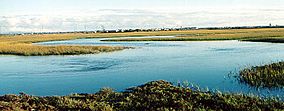Seal Beach National Wildlife Refuge
| Seal Beach National Wildlife Refuge | |
|---|---|
|
IUCN category IV (habitat/species management area)
|
|

Marsh wetlands of the Wildlife Refuge.
|
|
|
Map of the United States
|
|
| Location | Orange County, California, United States |
| Nearest city | Seal Beach, California |
| Coordinates | 33°44′16″N 118°04′27″W / 33.73772°N 118.07422°WCoordinates: 33°44′16″N 118°04′27″W / 33.73772°N 118.07422°W |
| Area | 911 acres (3.69 km2) |
| Established | 1972 |
| Governing body | U.S. Fish and Wildlife Service |
| Website | Seal Beach National Wildlife Refuge |
The Seal Beach National Wildlife Refuge is a wildlife refuge encompassing 965 acres (3.91 km2) located in the California coastal community of Seal Beach. Although it is located in Orange County it is included as part of the San Diego National Wildlife Refuge Complex. It was established in 1972.
The refuge is a collaboration between the United States Fish and Wildlife Service and the Department of the Navy. It serves as a critical habitat and winter stopover for many birds along the Pacific Flyway. Among the birds found at the refuge are great blue herons and the three endangered species: California clapper rail, California least tern, and Belding’s Savannah sparrow.
The refuge is located within Naval Weapons Station Seal Beach. Public access in the refuge is limited or restricted to once-a month tour (last Saturday of each month) as it is located within an active military base.
The subtidal zone is the shallow near-shore area below the intertidal zone, the land between the high and low tide marks. Subtidal is permanently inundated, except for rare lowest low tide events. There are four tidal basins created for the restoration of wetland: Forrestal Pond, Case Road Pond, 7th Street Pond, and Perimeter Pond, which are currently supporting the subtidal habitat in the Refuge. Tidal water from Anaheim Bay supports the ponds.
Dominating plants in these subtidal habitat is eelgrass, and mudflat portions in the habitat is supporting many invertebrate species.
The complex system of tidal channels delivers moisture and nourishment (oxygen and nutrients) throughout the habitat and providing food or pathway to food for fish and other organisms.
...
Wikipedia

